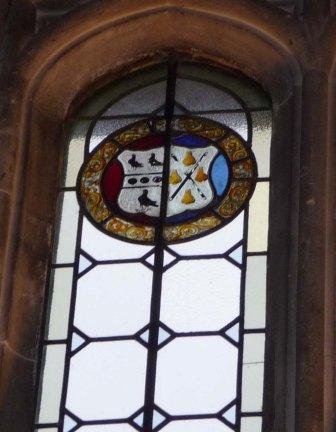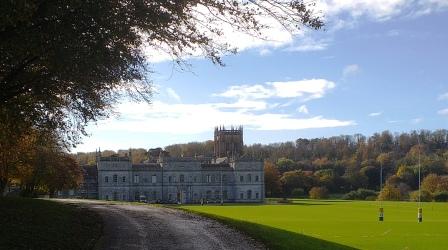|
To understand the motive underlying the violent proceedings revealed by the following law suit, it is necessary to correct the pedigree of the Tregonwell Family as printed in Hutchin's History of Dorset, Vol.I, p. 161. (Note: Also as now given by Wikipedia).
The mother of Sir John′s children was not his second, but his first wife, Elizabeth Bruce. Besides their son, Thomas Tregonwell, they had two daughters, Anne, wife of Sir Richard Rede, and Jane, wife of Robert Thornhull, Esq. On June 15th, 1549, Sir John Tregonwell and his second bride, Elizabeth, widow of Robert Martin, Esq. of Athelhampton Hall, and daughter of Sir John Kellaway of Rockbourne, were married in Puddletown Church. By her he had no children, but she broght him nine Martin step – children of whom the eldest daughter Anne became the wife of Thomas Tregonwell, only son to Sir John. Double inter–marriages are generally a prolific source of friction between families, and to complicate relationships, the said Thomas died before his father and his widow re–married to Sir Oliver Wallop, ancestor of the Earls of Portsmouth. Thus in the interval between the death of Sir John on January 13th, 1564, and the coming of age of his heir, there were two dowagers, half–a–dozen step–uncles and a bevy of half–brothers and sisters living at Milton Abbey with young John, son of Thomas.
The following law–suits show the result: Tregonwell v. Martin [Star Chamber Proceedings I 20/99] John Tregonwell of Mylton, Esq., states that Sir John Tregonwell, knt. (deceased) was, besides other lands, seized in fee of a great barne and 600 acres of arable in Mylton alias Mydleton which plaintiff as “cosen” and heir–at–law of Sir John, being son and heir of Thomas Tregonwell, Esq., decd., who was son and heir of Sir John, claimed by right of descent. But on the 11th day of December in the 16th year of Queen Elizabeth, James Martyn of Mylton, gent., George Bingham of Mylton, gent, John Wytterage of Mylton, yeoman, Christopher Devoll of Mylton, yeoman, John Chesman of Southover, husbandman, Rychard Moryshe of Mylton, husbandman, Humphrie Squibb of Melcombe, yeoman, John Melemouth of Mylton, husbandman, Henry Haley, William Hix of Melcombe, husbandman, John Chapman of Mylton, Jollefe Maypowder of Mylton, labourer, riotously assembled to disseise plaintiff of the barn and land, and a great quantity of corn in the barn valued at 550 marks. These persons “about 12 o′clock in the dead and deepe of the night ” arrived with bows, arrows, guns, swords, bills “and great long staves with pykes of stele in thend” and shouting and howling marched towards the barn. Two of the plaintiff′s servants were at the barn and after the rioters had broken open the door one of the plaintiff′s servants named Thomas Kexston was “deadly wounded and is not likely to recover” and the other Walter Bearde “with a sheaf of arrowes was fast nayled to the wall.” Subsequently the whole town was raysed and the constables and inhabitants dispersed the rioters. Some defendants (whose names are missing) answer that the barn and lands were not justly the property of plaitiff till the death of Dame Elizabeth Tregonwell widow of Sir John. Plaintiff is stated to have treated Dame Elizabeth discourteously and to have “presumed to beate and wound one of the manuel servants of Dame Elizabeth within her dwelling home where complainant was very friendly enterteyned” and also had maintained against Dame Elizabeth “an evill dyspozed woman comenlie taken, reputed and named in that countrey to be a witche.” Dame Elizabeth had granted the barne and land in trust to Richard Rogers and Thomas Moreton Esqrs. and William Sommaster gent. Thus ends the first law–suit and there was peace for eight years. The mention of William Sommaster suggests how an agreement was reached between the parties, for the young squire John Tregonwell was married to Anne, daughter of William Sommaster of Samborne, Hants, and doubtless got his barn and broad acres with her as a dowry. In the next legal procedings the Martins take the initiative. The old dowager Lady Elizabeth Tregonwell had at last died. Her son Nicholas Martin was not satisfied with what he got under her will so to law they went again and Nicholas made sure of an easy victory, as John Tregonwell was an invalid (and soon afterwards died). But, John′s wife proved herself a match for the high Sheriff and all his deputies.
Witness the following:– Who says Dorset ladies were the ‘weake vessels’ in those days? From: Somerset and Dorset Notes and Queries, Vol. XVII (1923), p. 67f. |


